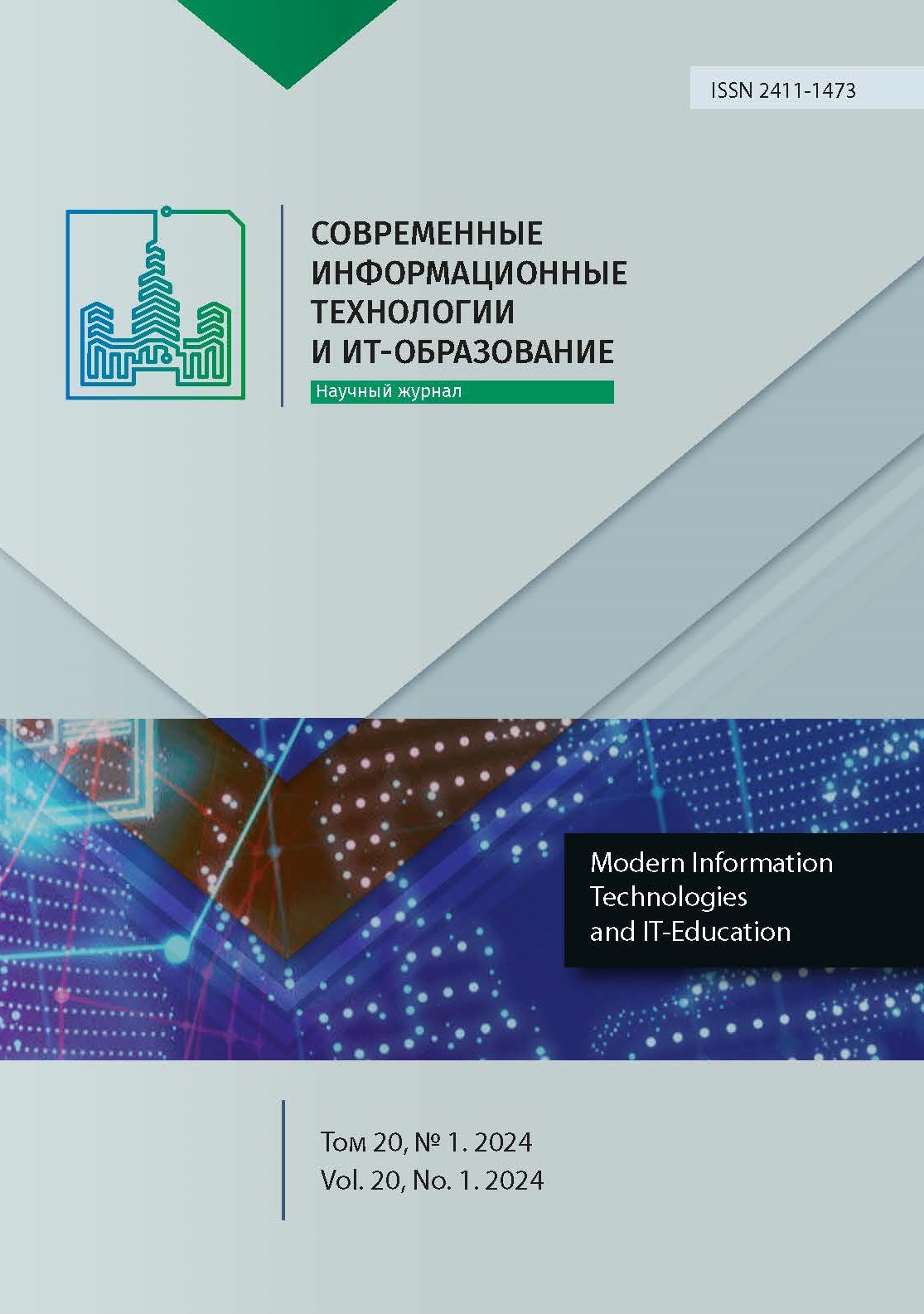Methods and Algorithms for Predictive Analytics of Time Series in Energy Consumption
Abstract
In the face of the climate crisis caused by global warming and large fluctuations in energy costs, urgent and proactive action on energy consumption is needed. States must minimize carbon dioxide emissions and businesses must optimize their energy costs. In this regard, improving energy efficiency plays a key role in solving the climate crisis and reducing costs for businesses. In most cases, energy efficiency improvements are proving to be the most cost-effective way to combat climate change, simultaneously reducing energy waste, saving money, and enabling affordable expansion of renewable energy. The active digitalization of the energy industry and the adoption of Internet of Things technologies create favorable conditions for the introduction of artificial intelligence in energy management. This paper presents an overview of Artificial Intelligence (AI) technologies and its potential application in energy management using an ice arena as an example. A dataset collected from a real-world facility representing a multidimensional time series was analyzed, and research on the application of deep learning in predictive model-based control was reviewed. Collectively, these studies demonstrated the potential of AI in the field of control theory. Most of them should be viewed as early exploratory work demonstrating the potential of using machine learning algorithms to solve applied problems in energy consumption.
References
2. Himeur Y., Ghanem K., Alsalemi A., Bensaali F., Amira A. Artificial intelligence based anomaly detection of energy consumption in buildings: A review, current trends and new perspectives. Applied Energy. 2021;287:116601. https://doi.org/10.1016/j.apenergy.2021.116601
3. Losi G., Bonzanini A., Aquino A., Poesio P. Analysis of thermal comfort in a football stadium designed for hot and humid climates by CFD. Journal of Building Engineering. 2021;33:101599. https://doi.org/10.1016/j.jobe.2020.101599
4. Petri I., Kubicki S., Rezgui Y., Guerriero A., Li H. Optimizing energy efficiency in operating built environment assets through building information modeling: A case study. Energies. 2017;10(8):1167. https://doi.org/10.3390/en10081167
5. Park J., Choi H., Kim D., Kim T. Development of novel PMV-based HVAC control strategies using a mean radiant temperature prediction model by machine learning in Kuwaiti climate. Building and Environment. 2021;206:108357. https://doi.org/10.1016/j.buildenv.2021.108357
6. Åkesson B.M., Toivonen H.T. A neural network model predictive controller. Journal of Process Control. 2006;16(9):937-946. https://doi.org/10.1016/j.jprocont.2006.06.001
7. Amalou I., Mouhni N., Abdali A. Multivariate time series prediction by RNN architectures for energy consumption forecasting. Energy Reports. 2022;8(9):1084-1091. https://doi.org/10.1016/j.egyr.2022.07.139
8. Rick R., Berton L. Energy forecasting model based on CNN-LSTM-AE for many time series with unequal lengths. Engineering Applications of Artificial Intelligence. 2022;113:104998, https://doi.org/10.1016/j.engappai.2022.104998
9. Kusdinar Y., Cahyani D., Mardiana R. Objective Thermal Comfort of Sport Facilities. In: Proceedings of the 3rd International Conference on Sport Science, Health, and Physical Education (ICSSHPE 2018). Advances in Health Sciences Research. Atlantis Press; 2019. p. 51-55. https://doi.org/10.2991/icsshpe-18.2019.14
10. Song C., Jing W., Zeng P., Yu H., Rosenberg C. Energy consumption analysis of residential swimming pools for peak load shaving. Applied Energy. 2018;220:176-191. https://doi.org/10.1016/j.apenergy.2018.03.094
11. Refaat S.S., Abu-Rub H., Kezunovic O.E.M. A novel smart energy management system in sports stadiums. In: 2016 18th European Conference on Power Electronics and Applications (EPE’16 ECCE Europe). Karlsruhe, Germany: IEEE Computer Society; 2016. p. 1-8. https://doi.org/10.1109/EPE.2016.7695647
12. Li Y., Nord N., Zhang N., Zhou C. An ANN-based optimization approach of building energy systems: Case study of swimming pool. Journal of Cleaner Production. 2020;277:124029. https://doi.org/10.1016/j.jclepro.2020.124029
13. Lu T., Lü X., Viljanen M. Prediction of water evaporation rate for indoor swimming hall using neural networks. Energy and Buildings. 2014;81:268-280. https://doi.org/10.1016/j.enbuild.2014.06.027
14. Santos E.T., Zárate l.E., Pereira E.M. Hybrid thermal model for swimming pools based on artificial neural networks for southeast region of Brazil. Expert Systems with Applications. 2013;40(8):3106-3120. https://doi.org/10.1016/j.eswa.2012.12.026
15. Yoon H.-J., Lee D.-S., Cho H., Jo J.-H. Prediction of Thermal Environment in a Large Space Using Artificial Neural Network. Energies. 2018;11(2):418. https://doi.org/10.3390/en11020418
16. Xiao-wei X. Study on the intelligent system of sports culture centers by combining machine learning with big data. Personal and Ubiquitous Computing. 2020;24:151-163. https://doi.org/10.1007/s00779-019-01307-z
17. Bouabdallaoui Y., Lafhaj Z., Yim P., Ducoulombier L., Bennadji B. Predictive Maintenance in Building Facilities: A Machine Learning-Based Approach. Sensors. 2021;21(4):1044. https://doi.org/10.3390/s21041044
18. Camacho E.F., Bordons C. Model Predictive Control. Advanced Textbooks in Control and Signal Processing. Springer Science & Business Media; 2013. 405 p. https://doi.org/10.1007/978-0-85729-398-5
19. Zhan S., Chong A. Data requirements and performance evaluation of model predictive control in buildings: A modeling perspective. Renewable and Sustainable Energy Reviews. 2021;142:110835. https://doi.org/10.1016/j.rser.2021.110835
20. Hou J., Li H., Nord N., Huang G. Model predictive control under weather forecast uncertainty for HVAC systems in university buildings. Energy and Buildings. 2022;257:111793. https://doi.org/10.1016/j.enbuild.2021.111793
21. Joe J., Karava P. A model predictive control strategy to optimize the performance of radiant floor heating and cooling systems in office buildings. Applied Energy. 2019;245:65-77. https://doi.org/10.1016/j.apenergy.2019.03.209
22. Fotopoulou M.C., Drosatos P., Petridis S., Rakopoulos D., Stergiopoulos F., Nikolopoulos N. Model predictive control for the energy management in a district of buildings equipped with building integrated photovoltaic systems and batteries. Energies. 2021;14(12):3369. https://doi.org/10.3390/en14123369
23. Li W., Xie L., Wang Z. Two-loop covert attacks against constant value control of industrial control systems. IEEE Transactions on Industrial Informatics. 2019;15:663-676. https://doi.org/10.1109/TII.2018.2819677
24. Feng X., Weng C., He X., Han X., Lu L., Ren D., Ouyang M. Online state-of-health estimation for Li-Ion battery using partial charging segment based on support vector machine. IEEE Transactions on Vehicular Technology. 2019;68:8583-8592. https://doi.org/10.1109/TVT.2019.2927120
25. Martínez F., Frías M.P., Pérez M.D., Rivera A.J. A methodology for applying k-nearest neighbor to time series forecasting. Artificial Intelligence Review. 2019;52:2019-2037. https://doi.org/10.1007/s10462-017-9593-z
26. Yu Z., Haghighat F., Fung B.C., Yoshino H. A decision tree method for building energy demand modeling, Energy and Buildings. 2010;42(10):1637-1646. https://doi.org/10.1016/j.enbuild.2010.04.006
27. Cotrufo N., Saloux E., Hardy J., Candanedo J., Platon R. A practical artificial intelligence-based approach for predictive control in commercial and institutional buildings. Energy and Buildings. 2020;206:109563. https://doi.org/10.1016/j.enbuild.2019.109563
28. Wang J., Li S., Chen H., Yuan Y., Huang Y. Data-driven model predictive control for building climate control: Three case studies on different buildings. Building and Environment. 2019;160:106204. https://doi.org/10.1016/j.buildenv.2019.106204
29. Ferreira P., Ruano A., Silva S., Conceicao E. Neural networks based predictive control for thermal comfort and energy savings in public buildings. Energy and Buildings. 2012;55:238-251. https://doi.org/10.1016/j.enbuild.2012.08.002
30. Privara S., Široky J., Ferkl L., Cigler J. Model predictive control of a building heating system: The first experience. Energy and Buildings. 2011;43(2-3):564-572. https://doi.org/10.1016/j.enbuild.2010.10.022
31. Mtibaa F., Nguyen K.-K., Dermardiros V., Cheriet M. A Model Predictive Control for Heat Supply at Building Thermal Inlet Based on Data-Driven Model. Buildings. 2022;12(11):1879. https://doi.org/10.3390/buildings12111879

This work is licensed under a Creative Commons Attribution 4.0 International License.
Publication policy of the journal is based on traditional ethical principles of the Russian scientific periodicals and is built in terms of ethical norms of editors and publishers work stated in Code of Conduct and Best Practice Guidelines for Journal Editors and Code of Conduct for Journal Publishers, developed by the Committee on Publication Ethics (COPE). In the course of publishing editorial board of the journal is led by international rules for copyright protection, statutory regulations of the Russian Federation as well as international standards of publishing.
Authors publishing articles in this journal agree to the following: They retain copyright and grant the journal right of first publication of the work, which is automatically licensed under the Creative Commons Attribution License (CC BY license). Users can use, reuse and build upon the material published in this journal provided that such uses are fully attributed.













